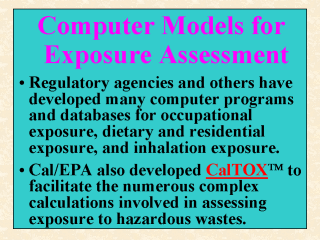| front |1 |2 |3 |4 |5 |6 |7 |8 |9 |10 |11 |12 |13 |14 |15 |16 |17 |18 |19 |20 |21 |22 |23 |24 |review |
 |
Regulatory
agencies and others have developed computer programs and databases not only for assessing
occupational exposure (Slide 14), dietary and residential exposure (Slide 20), or
inhalation exposure (Slide 21). Nor are pesticides the only environmental contaminants of
regulatory concern. The Love Canal environmental disaster led to a great deal of legislation in the United States during the 1970s regarding hazardous wastes and chemical dump sites. The Comprehensive Environmental Response, Compensation and Liability Act, otherwise known as Superfund, was apparently passed to provide direction and financial support for the clean-ups of hazardous wastes. To facilitate the health risk assessments required for this type of toxic substances, California Environmental Protection Agency (Cal/EPA, 1997) has developed a spreadsheet model that can systematically process the numerous complex exposure calculations involved. This model, known as CalTOX (tm) , was built upon the laws of mass conservation and chemical equilibrium which together constraint the way a chemical can move in the media. CalTOX first determines the time-dependent chemical concentrations in four exposure media (air in the breathing zone, drinking water, food, and soil) from 8 environmental compartments: air; ground water; surface water; plants; sediment; and 3 soil layers). It then uses the equations given in the federal Risk Assessment Guidance for Superfund (U.S. EPA, 1989) to estimate the exposures and risk. CalTOX has the capability of conducting Monte Carlo simulations, which as defined earlier (Slide 18) is a probabilistic analysis. |